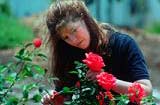Green Industry is Big Business
New study shows enormous economic impact for Florida
Written September 28, 2006; updated October 10, 2006.
A new University of Florida study reveals that total environmental horticulture industry sales in 2005 reached an estimated $15.24 billion. Florida is ranked second only to California in overall industry value.
UF/IFAS Food and Resource Economics associate professor Alan Hodges and professor John Haydu completed the survey between January and September 2005 by conducting telephone and interview surveys with more than 800 industry firms, including wholesale nurseries, landscape services, and horticultural retailers.
The study released September 28 at the Florida Nursery and Allied Trades Show (FNATS) shows enormous industry growth during the past five years despite extensive business interruptions caused by eight hurricanes in 2004 and 2005. The study also identifies the economic impact for each of Florida’s sixty-seven counties.
"The two largest industries in Florida are tourism and agriculture," said Ben Bolusky, FNGLA executive vice president. "The 'Green' industry represents agriculture’s bridge to tourism."
The study reported that nursery growers managed a total area of 82,440 acres in container, field, and greenhouse production systems and directly employed 190,000 people full-time and 104,000 seasonal or part-time people.
Bolusky said that Florida is the second largest nursery production state and 65 percent of indoor foliage plants sold in the U.S. are shipped from Florida. 42 percent of Florida’s nursery sales were to markets outside the state.
"Economically, the nursery and landscape industry has a big impact on Florida with many net positives," said Bolusky.
The study also evaluates the impacts on the horticulture industry of the eight named storms that struck Florida in 2004 and 2005. Total damages and losses due to hurricanes were estimated at $2.12 billion.
The Green Industry encompasses wholesale nursery and greenhouse producers, lawn and garden suppliers, equipment manufacturing companies, wholesale trade, landscape design, installation and maintenance services, lawn and garden stores, and other retail establishments selling plants and related lawn and garden goods.
"Plants create a world class tourist destination and an attractive place for Floridians to live," said Bolusky. "It’s a very vibrant industry made up of family farms and businesses and employing lots of Floridians."
The study, previously conducted in 2000, showed an economic impact of $9.9 billion. The newly released study shows the industry’s economic impact growth to be $5.34 billion.
Terrill Nell, UF/IFAS environmental horticulture chair, said Florida residents’ interest in gardening mirrors national trends, which include a high demand for plants, trees, shrubs and turf grass of all varieties. According to the National Gardening Association, 83 percent of all U.S. households, or an estimated 91 million households, participated in one or more types of do-it-yourself indoor and outdoor lawn and garden activities in 2005. Lawn and garden retail sales totaled $35.208 billion in 2005. A study by the Professional Landcare Network reports that homes with beautiful lawns and landscape can increase property values by 15 to 20 percent.
The study was sponsored by the Florida Nursery Growers and Landscape Association (FNGLA) and can be found at the Economic Impact Analysis Program website.
Adapted from:
UF study shows environmental horticulture industry has large economic impact in Florida by Emily E. Eubanks (9/2006).


